 Are you sure, when your painting, what it is you intend to have as your focus? Do you plan it, or just let it happen? Let’s take some time this month to get focused.
Are you sure, when your painting, what it is you intend to have as your focus? Do you plan it, or just let it happen? Let’s take some time this month to get focused.
The first question might be, “Do I need to havea focus?” I came up with a definition for a good composition a number of years ago. It seems to me that it can apply to music, drama, literature:
It is something that is so right that, to change any one part, would make it less right.
That requires subjective judgement, doesn’t it? It is a coming into balance, a rightness. Or as Rex Brandt said, “There is only ONE thing in a painting, the painting itself. Everything else is in relation to….”
Here are two non-objective paintings. Jackson Pollock brought the upper painting into a kind of  frenzied balance. It isn’t restful but it is contained. You might say that motion itself is the focus, or perhaps the red circles. I don’t want to change it. There is a balance within the frenzy.
frenzied balance. It isn’t restful but it is contained. You might say that motion itself is the focus, or perhaps the red circles. I don’t want to change it. There is a balance within the frenzy.
On the left, is Josef Albers’ Homage to the Square. Google him and study some of his other pieces. Do you have trouble staying on the square you have chosen for a focus? You move back and forth in the off-set squares. They are far from static.
Turning to representational work, the design is just as important but subject matter can get in the way. I believe in The Hammock Beckons you will agree the hammock is the focal shape. But it wasn’t alway so.
The hammock is on a point on our island. It always looks so very inviting as I row pass the point on my way to Orcas. That lure was what I wanted this painting to imply.
 An earlier version was going well until I completed the rocks. Then people who saw it would say, “What great rocks!”
An earlier version was going well until I completed the rocks. Then people who saw it would say, “What great rocks!”
“No,” I’d think, “Not the rocks. I want you to be drawn to the hammock.” What was wrong?
I had painted it with the proportions too true to those of the point. I decided I had to lower the small cliff, giving them a lesser % of the paper.
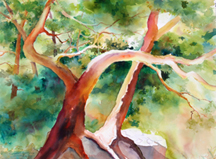 When the owner of the hammock saw the completed painting he said, “Howt I wish my bank was like this!” Don’t you want to climb in with a good book?
When the owner of the hammock saw the completed painting he said, “Howt I wish my bank was like this!” Don’t you want to climb in with a good book?
To get people to your focal area, it helps if you give them shapes on which they can move through your painting to your focus. With The Hammock Beckons, there are connected passages, literal stepping stones, that take you up to the hammock Your focal area is a point of visual resting, of slowing down a staying for a moment.
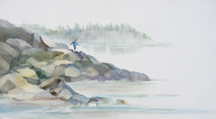 How can you be sure we know your focal shape? Use as many of the following as fit:
How can you be sure we know your focal shape? Use as many of the following as fit:
- Lightest light against darkest dark
- brightest color or a color that is not used anywhere else in the painting
- a singular shape (if you have all rectangles except for one circle — the circle better be in the focus!)
- if you have a diagonal, the strongest diagonal should point to or pass through the focus
- warmer beats cooler
- hard edges beat soft edges
- bright beats dull
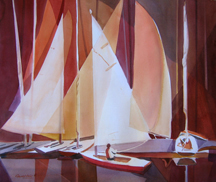
Check these in the hammock painting.
In Madrona Cliff, above, you travel up the near and more important tree — warmer colors, brighter colors, more value change– to the crossing diagonals. At that spot there is white paper and very strong darks behind the branch. Compare that branch to the large one on the left to see why one is the focus and one isn’t.
In The Young Explorer, upper right, the figure is the only shape that is different. Although it is not 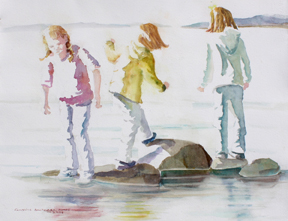 a warm color, the blue jacket is the only color that bright in the whole painting. Notice how the warmer, lighter planes of the rocks are used to lead you to the figure.
a warm color, the blue jacket is the only color that bright in the whole painting. Notice how the warmer, lighter planes of the rocks are used to lead you to the figure.
The only boat at an angle is obviously the focal shape in Looking for a Slot. How many other ways can you find that were used to make it more important than the other boats? (There are at least 4)
Which do you think is the focal figure in Dare I? Does the yellow jacket dominate? Or does the left girl who is facing us? Or does the focus teater between the two, making for a tippy focus that fits with the feeling of possibly losing their balance on slippery rocks? Is it a pleasing visual journey to move back and forth between the three girls? I hope so.
 By the way, they are all the same grand daughter. She was wearing a red jacket and playing by the shore on a February afternoon. To the right is the first version with the red jacket on all three positions. I had areadly changed the color changed on two.
By the way, they are all the same grand daughter. She was wearing a red jacket and playing by the shore on a February afternoon. To the right is the first version with the red jacket on all three positions. I had areadly changed the color changed on two.
I urge you to consider the ways you bring your viewer to your focus or main shape when you are designing your painting. Remember:
- Keep the colors a little brighter there.
- Be sure to push the values ( have both the lightest and the darkest).
- Watch your diagonals — have them leading to the focus instead of off the page.
- Don’t introduce something that is completely different from the rest of the painting or that has nothing to do with what you are trying to say. That imposter will steal the show.
- Give the viewers a pleasant or exciting or even threatening walk through your painting but design their trip.
- Give them a satisfying place to stop, and rest visually — rewarding both in design and content.
- And — keep it fresh, appearing effortless.
When your painting comes into a balance and there is nothing you think should be changed, you can say, “It is good.”
Keep your focus!
Happy painting,
Caroline
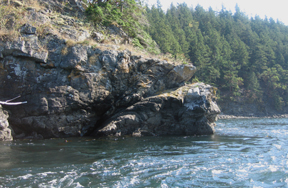
the backside of the hammock’s point
© Caroline Buchanan, 2011
